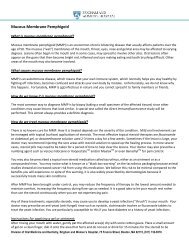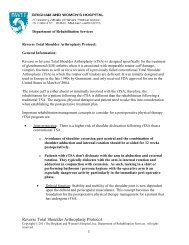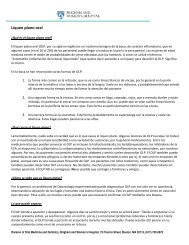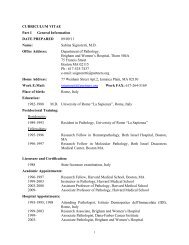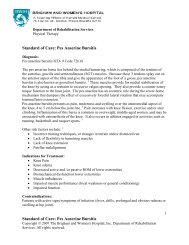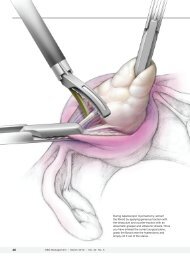Paralytic Strabismus: Third, Fourth, and Sixth Nerve Palsy
Paralytic Strabismus: Third, Fourth, and Sixth Nerve Palsy
Paralytic Strabismus: Third, Fourth, and Sixth Nerve Palsy
You also want an ePaper? Increase the reach of your titles
YUMPU automatically turns print PDFs into web optimized ePapers that Google loves.
<strong>Paralytic</strong> <strong>Strabismus</strong> 817<br />
secondary function: intorsion of the abducted eye on attempted downgaze. The<br />
torsional movement that indicates intact superior oblique function is best appreciated<br />
by observing a conjunctival vessel (Fig. 12).<br />
Differential Diagnosis<br />
The most common cause of acquired fourth nerve palsy is trauma. 31,49,50 The trochlear<br />
nerve is the longest <strong>and</strong> thinnest of all the cranial nerves, coursing along the<br />
free edge of the tentorium through the prepontine cistern, where it is vulnerable<br />
to crush or shearing injury. Fracture of the base of the skull is an alternative cause.<br />
In cases of bilateral traumatic fourth nerve palsies, both nerves are often injured at<br />
the anterior medullary vellum, where they decussate. 49 Traumatic fourth nerve<br />
palsies may occur after minor head injuries without loss of consciousness or skull<br />
fractures.<br />
Decompensated congenital fourth nerve palsy is also common <strong>and</strong> may present in<br />
adulthood. There is often a long-st<strong>and</strong>ing head tilt, which may be observed on inspection<br />
of prior photographs, <strong>and</strong> an insidious onset of intermittent vertical diplopia. Characteristic<br />
features of congenital fourth nerve palsy include inferior oblique overaction,<br />
large vertical fusional amplitude, <strong>and</strong> minimal torsional diplopia. The precise cause of<br />
congenital fourth nerve palsy is unclear but may include hypoplasia of the nucleus,<br />
birth trauma, anomalous muscle insertion, muscle fibrosis, structural abnormalities<br />
of the tendon, or inferior oblique muscle abnormalities. 51 Decompensation later in<br />
life probably relates to breakdown of vertical fusion leading to symptomatic diplopia,<br />
rather than progressive superior oblique dysfunction. 52<br />
Microvascular ischemia may cause fourth nerve palsy, typically in patients more<br />
than 50 years of age with vascular risk factors. There is often periorbital aching pain<br />
on presentation, which can be severe. There is an excellent chance of spontaneous<br />
recovery within several months.<br />
Fig. 12. A 75-year-old man (also shown in Fig. 20) with right third nerve palsy from pituitary<br />
apoplexy with spared superior oblique function. (A) A conjunctival vessel is observed (arrow)<br />
in primary gaze. (B) On attempted downgaze, the conjunctival vessel is observed to move<br />
from the 2 o’clock position to the 3 o’clock position (arrow), showing intorsion of the eye<br />
by an intact superior oblique muscle.




